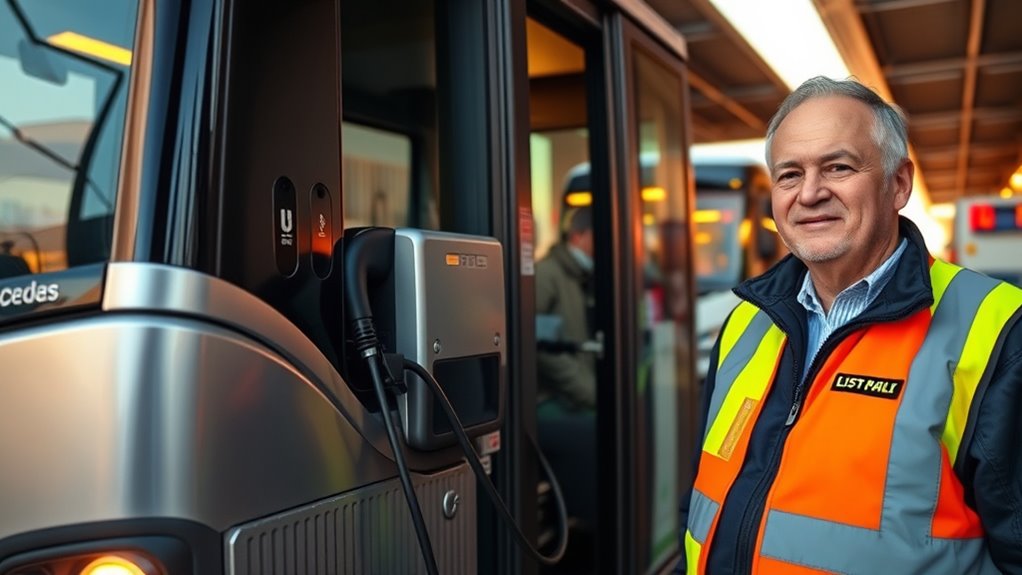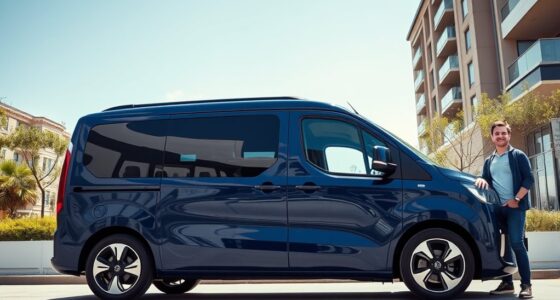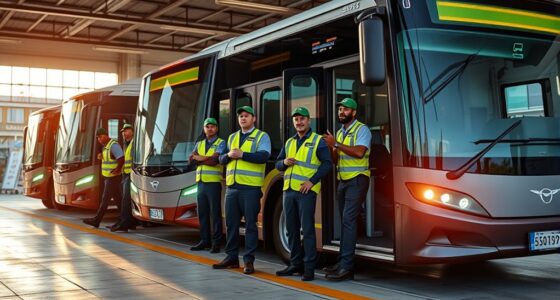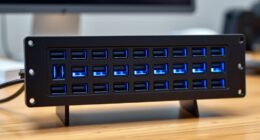Adapting to electric buses means you’ll face high upfront costs, complex infrastructure upgrades, and technical battery limitations that impact range and reliability. You’ll need to modify your routes and operations with smart planning and manage workforce training to guarantee safety and efficiency. Securing funding and steering regulatory hurdles can be challenging, but strong partnerships and long-term strategies are key. To succeed, understanding these obstacles is vital—discover how others are overcoming them as you explore more.
Key Takeaways
- High upfront costs and complex funding processes challenge operators during electric bus adoption.
- Infrastructure planning must align with routes and fleet size, requiring significant investment and coordination.
- Battery degradation and limited range demand strategic route design and real-time energy management.
- Workforce training for high-voltage systems and safety procedures is essential for smooth transition.
- Navigating regulatory permits and securing permits can delay infrastructure development and fleet deployment.
Overcoming Financial Barriers and Initial Investment Hurdles
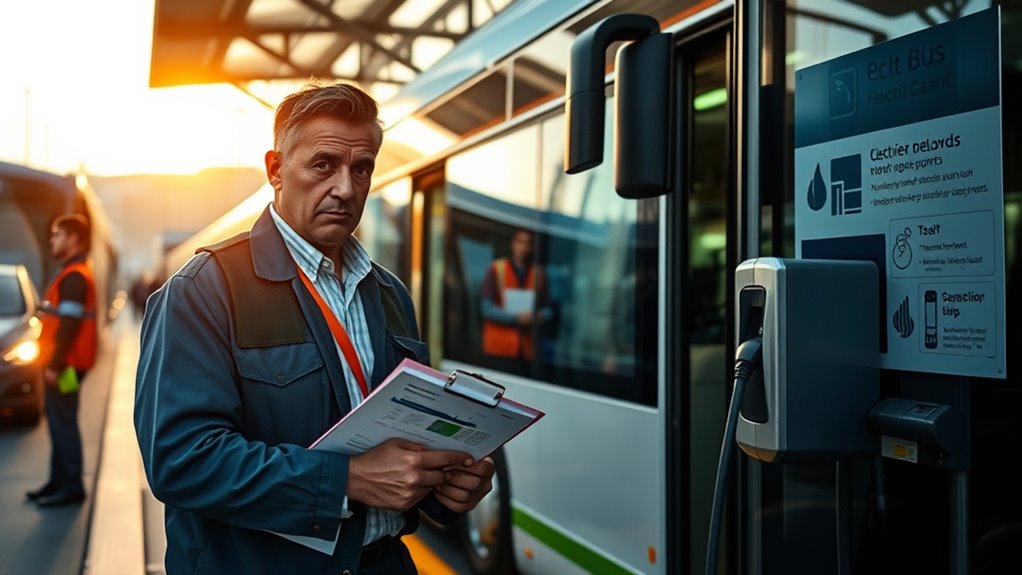
Switching to electric buses presents significant financial challenges, primarily due to their higher upfront costs. You’ll find that electric buses cost about 50% more than traditional diesel buses, making initial investments steep.
While the total cost of ownership can be lower over time thanks to savings on fuel and maintenance, the upfront expense remains a major hurdle. You’ll rely heavily on government incentives, grants, and subsidies to offset these costs, but uncertainty in federal funding can complicate planning. Moreover, the initial investment process can be complex, requiring careful financial analysis and planning to ensure sustainability. Additionally, the need for multiple vehicles due to shorter ranges and the high price of replacing older fleets add to the financial strain. Without clear long-term financial strategies, managing these costs becomes even more difficult, making the [exchange] a complex balancing act of upfront investment versus future savings. Developing a comprehensive financial planning strategy can help operators better navigate these challenges and ensure successful transitions. Proper understanding of the technology adoption process and the cost-benefit analysis involved is also essential for smooth implementation and long-term success.
Building and Upgrading Charging Infrastructure in Urban Environments
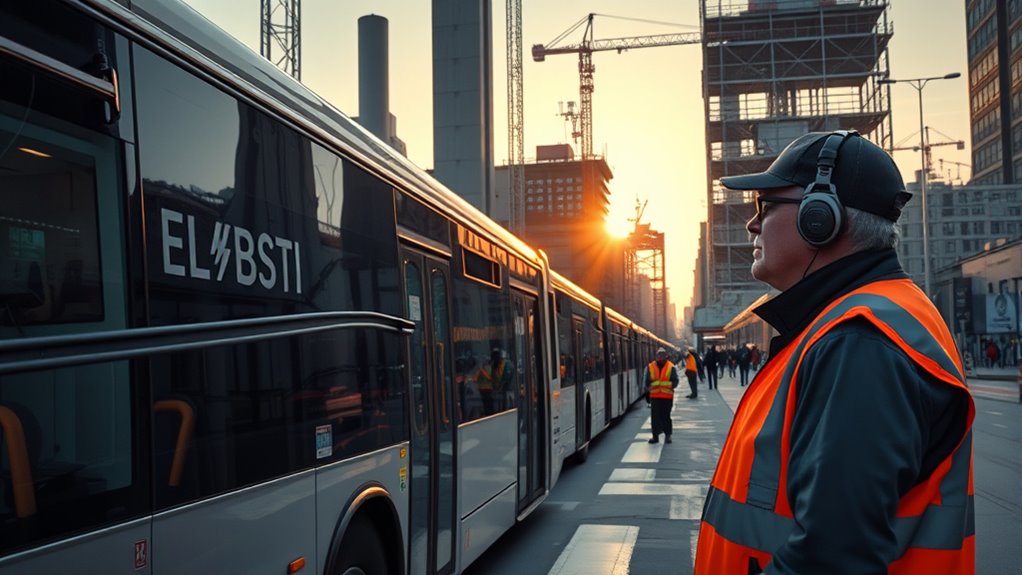
Building and upgrading charging infrastructure in urban environments requires careful planning to meet the demands of an electric bus fleet. You need to assess fleet size and route schedules to determine the power capacity needed for simultaneous charging, especially overnight.
Effective urban charging infrastructure requires careful planning aligned with fleet size and route schedules.
Selecting the right technology—whether slow overnight chargers or fast chargers—depends on operational needs. Planning for scalability is essential, so infrastructure can expand without costly retrofits, often through modular stations.
Safety compliance involves using fire-resistant materials and following electrical standards. You must also ensure proper ventilation and emergency shutdown procedures to minimize risks.
Positioning charging stations strategically within depots minimizes vehicle downtime and streamlines driver routines. Additionally, considering juice yield from citrus fruits can be useful for planning energy needs, as fresh, high-quality power sources contribute to efficient charging.
You must also consider local grid constraints, upgrading transformers and managing peak demand with smart charging. Collaborating with utility providers guarantees long-term infrastructure support, making the transition smoother and more reliable.
Additionally, understanding personality dynamics within teams can help optimize operational efficiency and staff adaptability during the transition.
Navigating Technical Limitations of Battery Performance
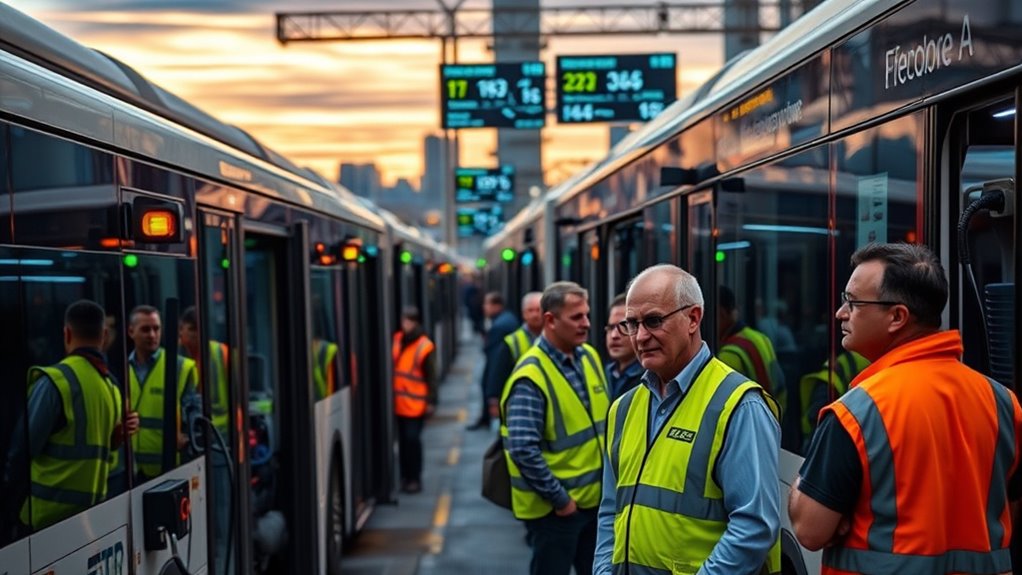
Understanding the technical limitations of battery performance is essential when shifting to electric buses, as battery degradation directly impacts vehicle range and reliability. Over six years, lithium-ion batteries typically lose about 12% of their capacity, which can reduce usable energy and affect operational schedules. Proper management of charging cycles can help mitigate some of these effects and extend battery life. Factors like temperature, charge cycles, and usage patterns accelerate this degradation, especially once batteries hit a “knee point” where deterioration speeds up. Most batteries retain 60-80% of their original capacity at end-of-life, but ideal conditions—temperatures between 15–35°C—help prolong their lifespan. Regular monitoring and managing charge levels prevent early decline, and employing battery management systems can optimize performance and longevity. Additionally, understanding the capacity fade rate allows operators to better forecast remaining useful life and plan maintenance accordingly. Recognizing these limits and implementing proper thermal management strategies can significantly improve battery longevity. Replacing batteries around 70% capacity ensures continued performance. Recognizing these limits allows you to plan routes effectively and avoid unexpected disruptions caused by degraded battery performance.
Adapting Operations and Route Planning for Electric Bus Efficiency
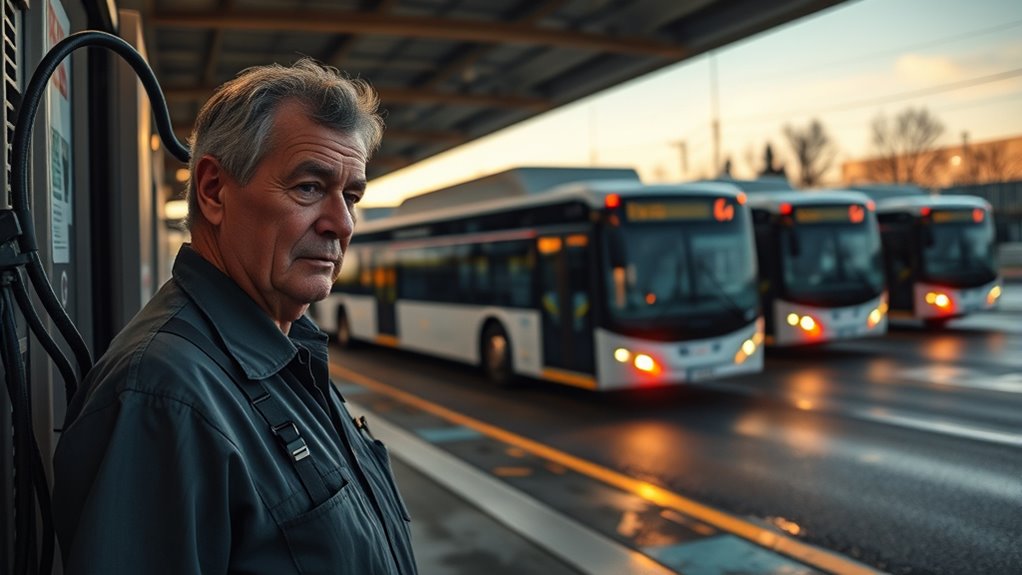
Efficient operation of electric buses depends on smart route design and infrastructure planning that align with their energy capacities. You’ll need integrated optimization models that combine bus routes, charging station placement, battery choices, and scheduling to balance energy needs and operational efficiency.
Real-time adjustments, using rolling horizon approaches, help optimize charging schedules during service, accommodating delays or energy fluctuations.
Strategic placement of charging stations minimizes costs while ensuring buses stay within energy limits. Predictive energy consumption models, based on real-world data, help align charging demand with grid capacity and reduce downtime.
Drive cycle analysis identifies energy-intensive segments, guiding route adjustments, while dynamic rerouting tools respond to traffic and weather changes.
Battery-aware routing prevents routes exceeding energy limits, ensuring smoother, more reliable operations.
Ensuring Regulatory Compliance and Securing Policy Support
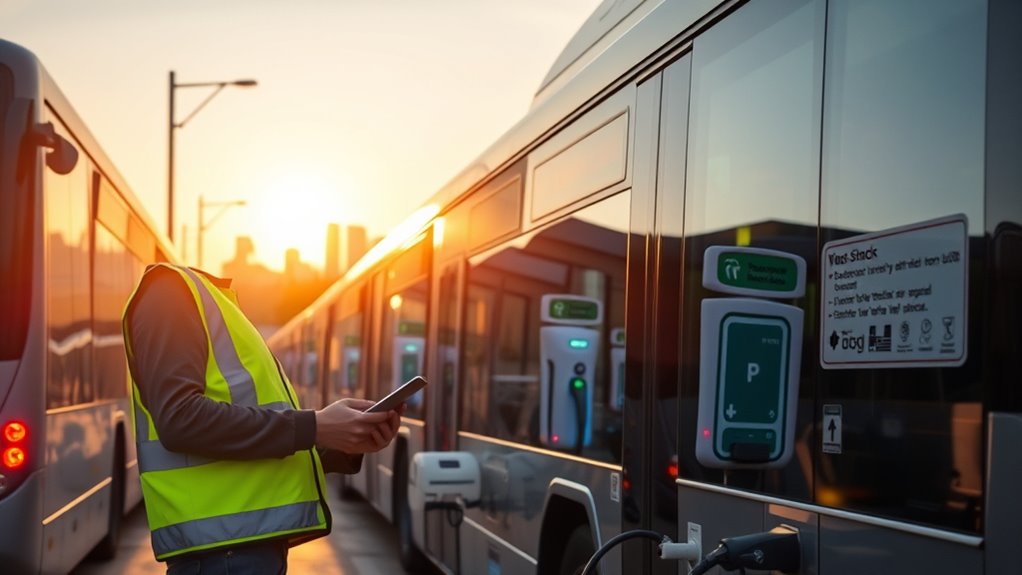
Managing the complex landscape of regulations and policies is crucial for the successful shift to electric buses. Outdated regulations often lag behind technology, creating compliance hurdles, while the absence of standardized charging protocols complicates interoperability across regions. StrongMocha offers a potential avenue for transportation agencies to diversify their investment portfolios and hedge against economic uncertainties, which can support funding efforts. Grid upgrades strain budgets because policies rarely mandate utility collaboration, and V2G integration faces barriers without clear regulatory guidance. Permitting delays stem from ambiguous zoning laws. Accessing financial incentives is also challenging; grant applications are complex, and inconsistent subsidies disrupt planning. High upfront costs persist despite incentives, and staff retraining often lacks dedicated funding. Safety compliance adds costs and delays, with evolving standards for batteries, fire codes, and cybersecurity. Coordination issues between utilities and agencies further hinder progress, emphasizing the need for unified, adaptable policies to support a smooth transition. Additionally, training programs for personnel are often insufficient, impacting the overall implementation process. Furthermore, adopting ethical hacking practices can help identify vulnerabilities in the new infrastructure and ensure cybersecurity measures are robust to protect sensitive data and assets.
Developing Long-term Strategies Amid Technological Changes

Developing long-term strategies for electric bus adoption requires staying ahead of rapid technological changes. As battery technology and charging solutions improve, your fleet’s performance and range will likely increase, making electric buses more practical. Incorporating sound healing science and understanding its impact on sleep and relaxation can also support driver well-being during long shifts. To support this, you need to build or upgrade charging infrastructure and assess your electricity grid’s capacity. Strategic planning is essential to align operations with sustainability goals, including managing peak demand with smart charging schedules. Creating a thorough fleet renewal plan that considers supply chain logistics and charging capacity ensures long-term reliability. Additionally, staying informed about advancements in battery storage can help optimize energy use and reduce costs over the vehicle lifecycle. Evaluating your energy efficiency practices can further enhance operational sustainability and reduce overall costs. Monitoring cookie management practices can also aid in understanding user interactions and improving your digital infrastructure to support operational transparency. While electric buses can lower operational costs, success depends on effectively integrating these technological advancements. Staying informed about market trends and evaluating vehicle compatibility will help you adapt quickly, ensuring your transition remains sustainable and cost-effective.
Managing Workforce Training and Passenger Experience During Transition
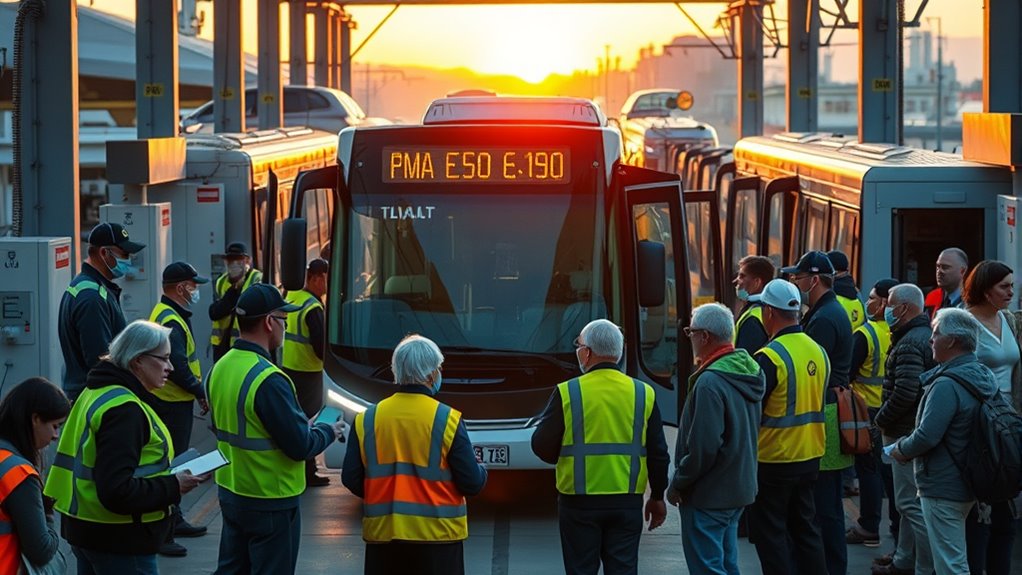
Switching to electric buses presents unique workforce training and passenger experience challenges that require proactive strategies. You’ll need to guarantee technicians receive specialized training on high-voltage systems, handling equipment, and emergency procedures. Developing extensive curricula involves collaboration between manufacturers, operators, and educational institutions. No-cost familiarization sessions can help prep workers before product-specific training begins. Safety must be a priority, with risk assessments and compliance with safety standards essential to prevent accidents. Additionally, understanding nutritional advantages of green juice can serve as an example of how proper education enhances acceptance of new technologies. Engaging training programs that incorporate real-world scenarios can significantly improve technician readiness. Incorporating industry standards into the training ensures compliance and safety across operations. On the passenger side, benefits like lower noise and reduced emissions enhance comfort and community health. Educating passengers about these advantages boosts acceptance. Managing the transition also involves coordinating training schedules, planning fleet upgrades, and ensuring infrastructure readiness. Addressing these aspects upfront helps smooth the transition and maintains service quality. Moreover, emphasizing digital literacy programs can empower staff and passengers to adapt more effectively to the technological changes involved.
Forming Effective Partnerships to Share Resources and Risks
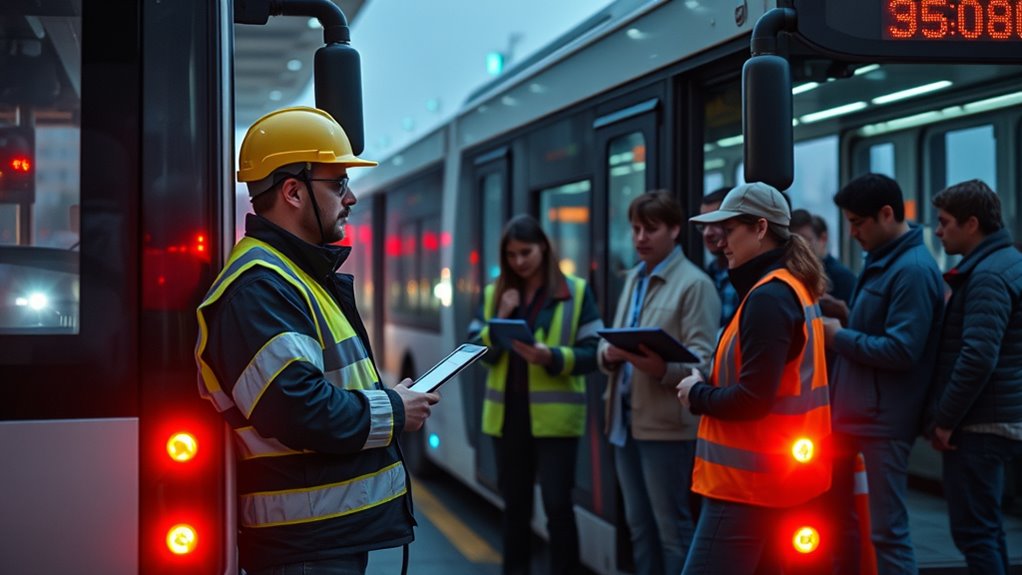
Building strong partnerships is key to effectively sharing resources and distributing risks involved in deploying electric buses. Collaborating with utility providers ensures you have reliable charging infrastructure, while working with infrastructure experts helps optimize placement and system design. Engaging with specialists knowledgeable in sustainable practices, such as those experienced in eco-friendly materials, can also contribute to environmentally conscious deployment strategies. Partnering with private sector companies can accelerate technology adoption and provide innovative solutions. Engaging government agencies can facilitate funding and streamline regulatory processes, easing financial burdens. Specialized consulting firms bring expertise in electrification strategies, helping you maximize operational efficiency. Forming alliances with research institutions and EV manufacturers ensures access to cutting-edge technology tailored to your needs. Additionally, working with environmental groups, local authorities, and community organizations fosters support and smooth integration. These strategic partnerships distribute costs, reduce risks, and accelerate your progression to sustainable transportation.
Frequently Asked Questions
How Do Operators Measure the Long-Term Financial Benefits of Electric Buses?
You measure the long-term financial benefits of electric buses by analyzing key metrics like lower operating costs, reduced maintenance expenses, and fuel savings.
You compare the initial investment against ongoing savings over time, considering factors like payback period and external investment impacts.
Data-driven models and simulations help you assess economic benefits, while incentives and financing options make the shift more financially feasible.
What Strategies Are Effective for Urban Charging Station Placement Amidst Space Constraints?
Think of your urban space as a puzzle, where each piece must fit perfectly. To optimize charging station placement, you should leverage space-efficient solutions like terminal-based stations, on-route opportunity chargers, and multi-level facilities.
Use AI-driven scheduling and shared infrastructure to maximize land use. Mobile units and weather-resilient siting further enhance access, ensuring your electric bus network stays reliable without sacrificing precious urban space.
How Can Battery Technology Advancements Improve Route Reliability and Operational Flexibility?
Battery technology advancements greatly boost your route reliability and operational flexibility.
With higher energy density, your buses can travel longer distances, reducing the need for frequent stops.
Fast charging minimizes downtime, letting you quickly recharge during layovers.
Smart Battery Management Systems optimize performance and safety, preventing failures.
Modular swaps and wireless charging give you more flexibility, ensuring your fleet stays on schedule even under demanding conditions.
What Best Practices Ensure Smooth Integration of Electric Buses Into Existing Transit Schedules?
To guarantee smooth integration of electric buses into your schedules, start by analyzing your routes to match bus range and charging needs.
Develop a thorough fleet management plan, including demand management and opportunistic charging strategies.
Train your staff thoroughly and communicate regularly with stakeholders and OEMs.
Keep updated on policies and technological advancements, and engage in pilot programs to refine procedures before full deployment.
This proactive approach helps optimize operations and minimizes disruptions.
How Do Policies Influence the Pace and Scale of Electric Bus Adoption in Cities?
You see, policies play a crucial role in shaping how quickly and widely electric buses are adopted in cities. When governments implement supportive regulations, offer financial incentives, and invest in infrastructure, they make it easier for you to shift smoothly.
These policies reduce costs, mitigate risks, and encourage private investments, ultimately speeding up the adoption process and expanding electric bus fleets, benefiting both operations and environmental goals.
Conclusion
Shifting to electric buses isn’t a walk in the park, but with determination and smart planning, you can turn challenges into opportunities. By staying ahead of technological changes, forging strong partnerships, and listening to operator stories, you’ll prove that every cloud has a silver lining. Remember, when the going gets tough, the tough get going—your efforts today pave the way for a cleaner, more sustainable tomorrow. Keep pushing forward; success is just around the corner.
